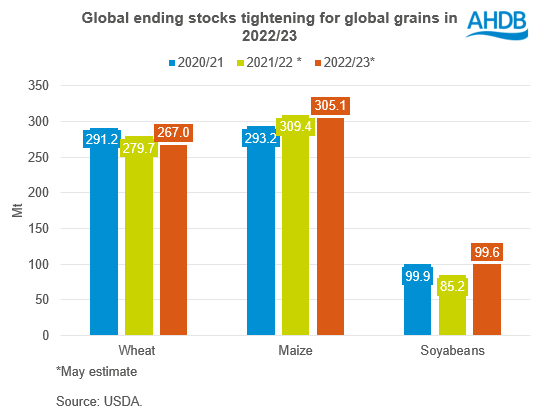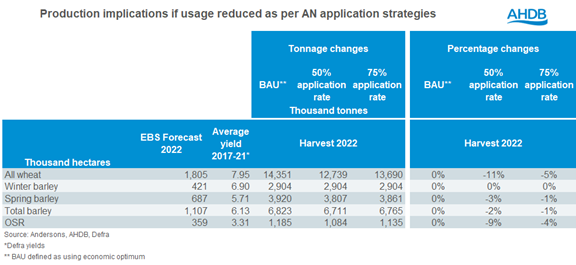Production impacts from reduced nitrogen fertiliser strategies: Grain market daily
Friday, 13 May 2022
Market commentary
- UK feed wheat (May-22) gained £4.65/t yesterday to close at £348.65/t. The new-crop contract (Nov-22) gained the same amount yesterday, closing at £333.15/t. Both contract highs, ahead of the latest world agricultural supply and demand estimates (WASDE) yesterday evening.
- Global grain contracts saw large gains in response to the WASDE release last night, showing a tightening global supply and demand balance for 2021/22 and 2022/23. See further details below. Chicago wheat (Dec-22) gained $23.51/t yesterday, to close at $435.92/t. Paris wheat (Dec-22) jumped up €10.75/t, to close at €407.50/t.
- This morning, following global wheat and maize prices up, the UK feed wheat (Nov-22) futures contract was trading at £339.50/t (13:30BST).
- Paris rapeseed futures remained relatively unchanged yesterday. The Nov-22 contract closed down €0.25/t yesterday, to €835.25/t.
Tightening global grain supply 2022/23
The first new season (2022/23) USDA world agricultural supply and demand estimates (WASDE) were released yesterday evening.
The outlook for global wheat next season (2022/23) is for increased trade, lower supplies and consumption, and lower ending stocks. Lower year-on-year forecasted production in Australia (-6.3Mt), Ukraine (-11.5Mt) and Morocco outweighed increased crop outlooks for Russia (+4.8Mt), Canada (+11.3Mt), and the US (+2.3Mt) (considering dry conditions last season).
The maize outlook for 2022/23 also looks for one of lower production and reduced ending stocks. This is down to reduced crop forecasts for Ukraine (-22.6Mt), the US (-16.6Mt), the EU (-2.2Mt), and China (-1.6Mt). These declines outweigh increased forecasted production in Brazil (+10.0Mt), Argentina (+2.0Mt), South Africa (+1.0Mt) and Serbia. World imports are forecasted to fall 2.3%, with large year-on-year falls for the UK, Brazil, EU, Canada, and China.
Global oilseed production is forecasted up 50.3Mt year-on-year, to 647.1Mt. Last year, drought hit the Canadian rapeseed and South American soyabean crops. Global soyabean production for 2022/23 is forecasted up 45.3Mt to 394.7Mt, mostly on account of an increased Brazilian crop.

Production impacts from reduced nitrogen fertiliser strategies
High input costs are front and foremost of growers minds. UK produced Ammonium Nitrate (AN) increased 182% between Jun-21 and Mar-22, to a price of £839.00/t. With the outlook for natural gas prices (the feed stock for AN) well supported, driven by the war in Ukraine, it is well to assume that fertiliser prices could stay strong for the foreseeable future. With high input costs, we may well see a shift in fertiliser use this season and next, or potentially an impact in planted area for those crops which are more input intensive.
Last Friday, Mark explored different nitrogen application strategies. These highlighted the economic impact to the grower of either applying fertiliser as per the recommended economic amount, or reducing it by either 25% or 50% this season. The results of this can be found here. This week, I look at what these scenario outcomes could equate to for UK production overall.
The scenarios
The below tables outline the scenarios put forward and the predicted impact on crop yields. For production impacts, I have taken three of these scenario’s:
- Applying at the usual recommended amount for 2022
- Applying 75% of the typical application rate for 2022
- Applying 50% of the typical application rate for 2022



Yields were predicted to fall 2% under the economic optimum for winter feed wheat compared to 11% if AN (ammonium nitrate) fertiliser was applied at half rate. For winter rape this was a decline of 3% under the economic optimum and a fall of 9% if AN applied at 50% of the typical amount.
The results
Using the area’s forecast from the AHDB’s Early Bird Survey, against the 5-year average Defra yield, winter wheat production could increase this year to c.14.4Mt. This would be an increase of just under 400Kt on the year.
However, should we see nitrogen fertiliser application rates drop by 50%, production could potentially be 11% less than the BAU scenario. This is purely driven by the yield impact as a result of reduced fertiliser application, and does not take into account macro factors, such as weather. By reducing fertiliser applications by only 25%, unsurprisingly the yield impact is less, but potential production could still reduce by 5%.
We know that, as at the end of April, 83% of the winter wheat crop was rated “good-excellent”. However, rain was needed to fulfil it’s full yield potential and May has been dry to date.

A fertiliser reduction strategy has less of an impact on the barley output, with only spring barley crops being affected. Applying nitrogen at 50% BAU levels could see UK spring barley production back 3%, but just reduced by 1% should 75% of intended nitrogen fertiliser be used instead.
Oilseed rape sees a larger fall in potential production if fertiliser is reduced by 50%. Given that the planted area is forecast to be the second lowest this century, and the tight balance sheet both globally and domestically being felt for the crop, any downward revision to production is going to exacerbate this situation.
Conclusion
As outlined last week, there was no significant economic impact to the grower from these different nitrogen fertiliser application approaches. However, both fertiliser and grain prices will change over the next 18 months, especially given their volatility of late. So, a prudent and exacting approach to fertiliser applications is a wise move, whatever application strategy applied.
Next week, I will look ahead to potential impacts for harvest 2023 – providing scenarios that incorporate not only different reduced nitrogen applications but hypothetical area reductions for some crops given the current high input costs.
Assumptions
Yield impacts taken from Defra average yield for all wheat, as no official split for milling/feed
Winter barley - no N reduction to yields
Assuming EBS area is realised
Spring feed barley yield reduction applied to only proportion of feed barley area. Assuming that minimal applications to malting barley anyway, to keep N levels low for maltsters
BAU = using economic optimum, as defined by AHDB Farmbench
Assume that malting/feed proportion of area is same for winter and spring barley
Total OSR area is all Winter OSR - nothing taken off for (minimal) SOSR area
Sign up for regular updates
You can subscribe to receive Grain Market Daily straight to your inbox. Simply fill in your contact details on our online form and select the information you wish to receive.
While AHDB seeks to ensure that the information contained on this webpage is accurate at the time of publication, no warranty is given in respect of the information and data provided. You are responsible for how you use the information. To the maximum extent permitted by law, AHDB accepts no liability for loss, damage or injury howsoever caused or suffered (including that caused by negligence) directly or indirectly in relation to the information or data provided in this publication.
All intellectual property rights in the information and data on this webpage belong to or are licensed by AHDB. You are authorised to use such information for your internal business purposes only and you must not provide this information to any other third parties, including further publication of the information, or for commercial gain in any way whatsoever without the prior written permission of AHDB for each third party disclosure, publication or commercial arrangement. For more information, please see our Terms of Use and Privacy Notice or contact the Director of Corporate Affairs at info@ahdb.org.uk © Agriculture and Horticulture Development Board. All rights reserved.



